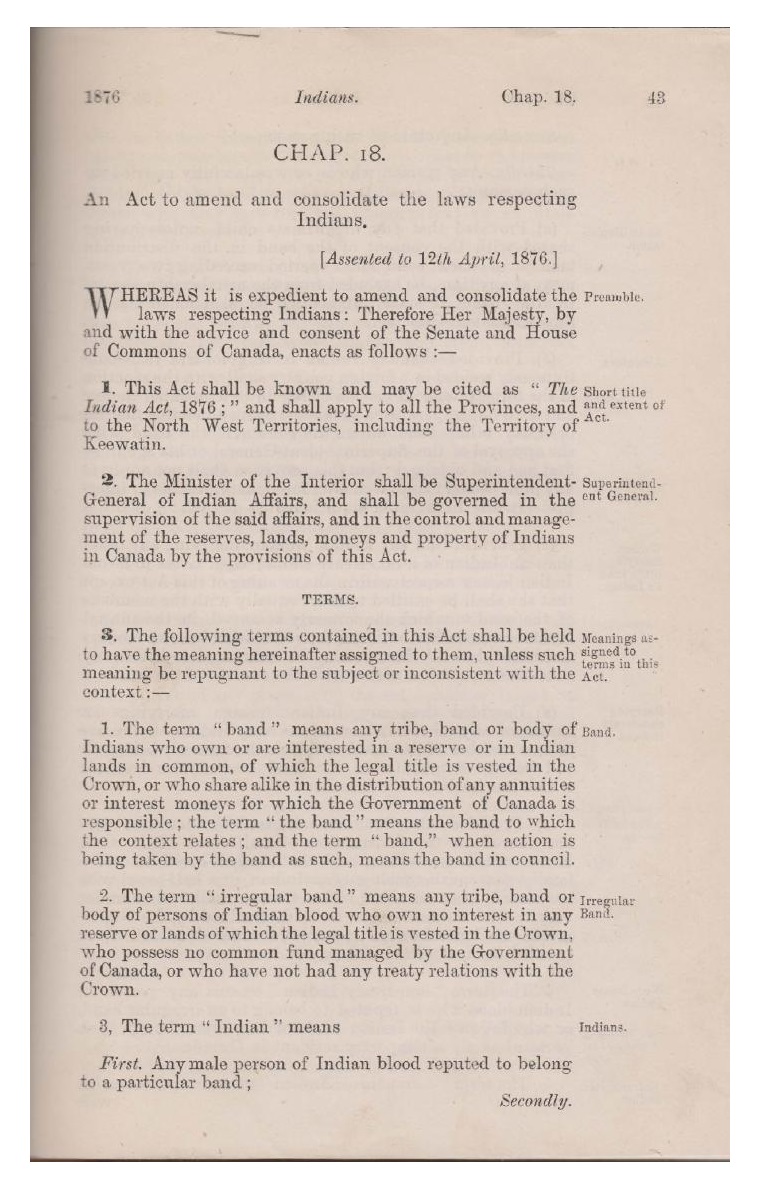
Section 91(24) of the British North America Act, 1867 (now the Constitution Act 1982) grants Parliament legislative authority over Indians and Indian lands. The Indian Act was launched in 1876 by Canada and represents the amalgamation of legislation, statutes and regulations pertaining to Indians that had earlier been in place in the colonies of Upper and Lower Canada. At the time of its inception
the Indian Act was designed to fulfill the continuation of the federal government’s civilizing and assimilation goals. Perceptions of Indians as ‘wards of the state’ requiring tutelage and protection resulted in early statutes designed to protect First Nations from white society. This simultaneously served to move Indigenous populations onto reserves and conveniently out of the way of settlers who sought to pre-empt and develop land.
Prior to Confederation, the majority of statutes pertaining to Indians concerned the banning of alcohol, the definition of Indian, enfranchisement, as well as statutes which empowered the colonies to administer and manage Indian lands. The assimilation goal became explicit in the 1857 Civilization of Indian Tribes Act whereby enfranchisement was applied to those Indians who had acquired a reasonable degree of education, were free from debt, could read and write, and were capable of managing their own affairs. Early legislation also considered the rights of non-Indians who settled on Indian lands pending the receipt of a government permit, as stipulated in an 1861 Province of Canada statute. For the most part, the 1861 statutes began to adopt the now familiar Indian Act format, with the amalgamation of other jurisdictions of Indian legislation giving form and content to the Province of Canada’s early Indian policy.
Invariably, changes to federal Indian policy were achieved through piecemeal amendments to the Indian Act. For example, Chap. 17, section 1 of, “An Act to amend the Indian Act, 1880” provided the Governor in Council with the authority to prohibit or regulate the sale of agricultural produce grown by Indians. Other amendments include the 1884 banning of the Potlatch and creation of the Pass System (that prevented Indians from leaving prairie reserves without permission of government agents), the 1895 prohibition of the Sun Dances, and the amendment that in the early 20thcentury made school attendance mandatory (filling the rosters of residential schools). Arguably, the 1880 repeal and amendment of various clauses pertaining to agriculture infringed on treaty rights. 1951 and 1985 represent the often-noted Indian Act amendment dates which removed some of the most blatantly assimilationist and sexist elements of the Indian Act – such as those that caused first Nations women to lose their Indian status upon marriage to a white man.
